How Much Did Urban Park Use Change under the COVID-19 Pandemic? A Comparative Study of Summertime Park Use in 2019 and 2020 in Edinburgh, Scotland
Abstract
:1. Introduction
2. Background
2.1. The Place of Urban Parks
2.2. COVID-19 Restrictions on People’s Activities in Scotland
2.3. Changes in Park Usage as a Result of COVID-19
2.4. Understanding Human Behaviours in Urban Parks
3. Methodology
3.1. Research Design
3.2. Step 1: Site Selection
3.3. Step 2: Preparation for Observations
3.4. Step 3: On-Site Observation
3.5. Step 4: Post-Processing/Mapping
3.6. Step 5: Analysis
4. Results
4.1. User Participation
4.2. Age and Gender
4.3. Activity Categories
4.4. Social Categories
4.5. Group Size and Experienced Density of People
4.6. Park Usage
5. Discussion
Limitations
6. Conclusions
Author Contributions
Funding
Institutional Review Board Statement
Informed Consent Statement
Data Availability Statement
Conflicts of Interest
Appendix A. Behaviour Observation Zones for Each Park
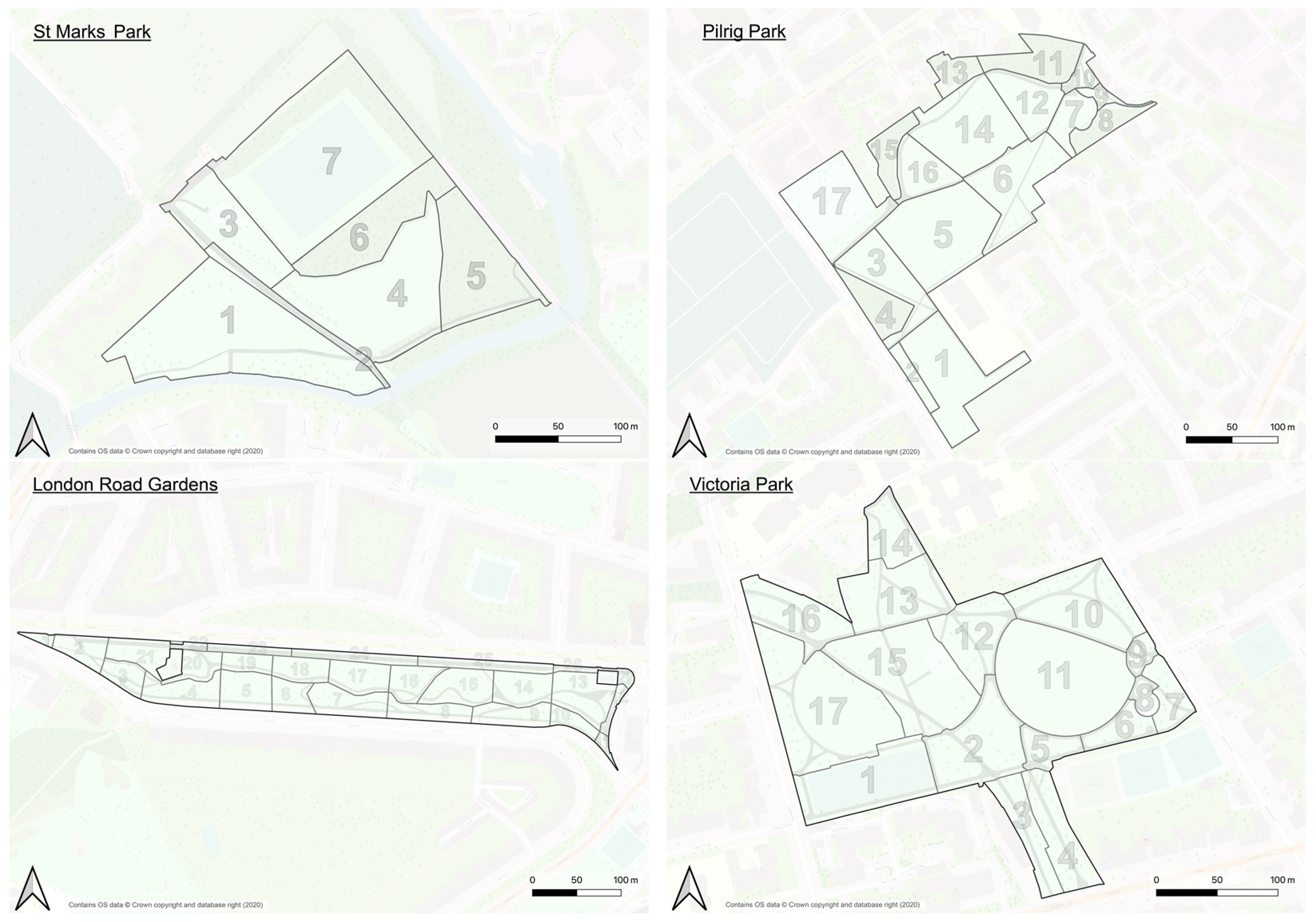
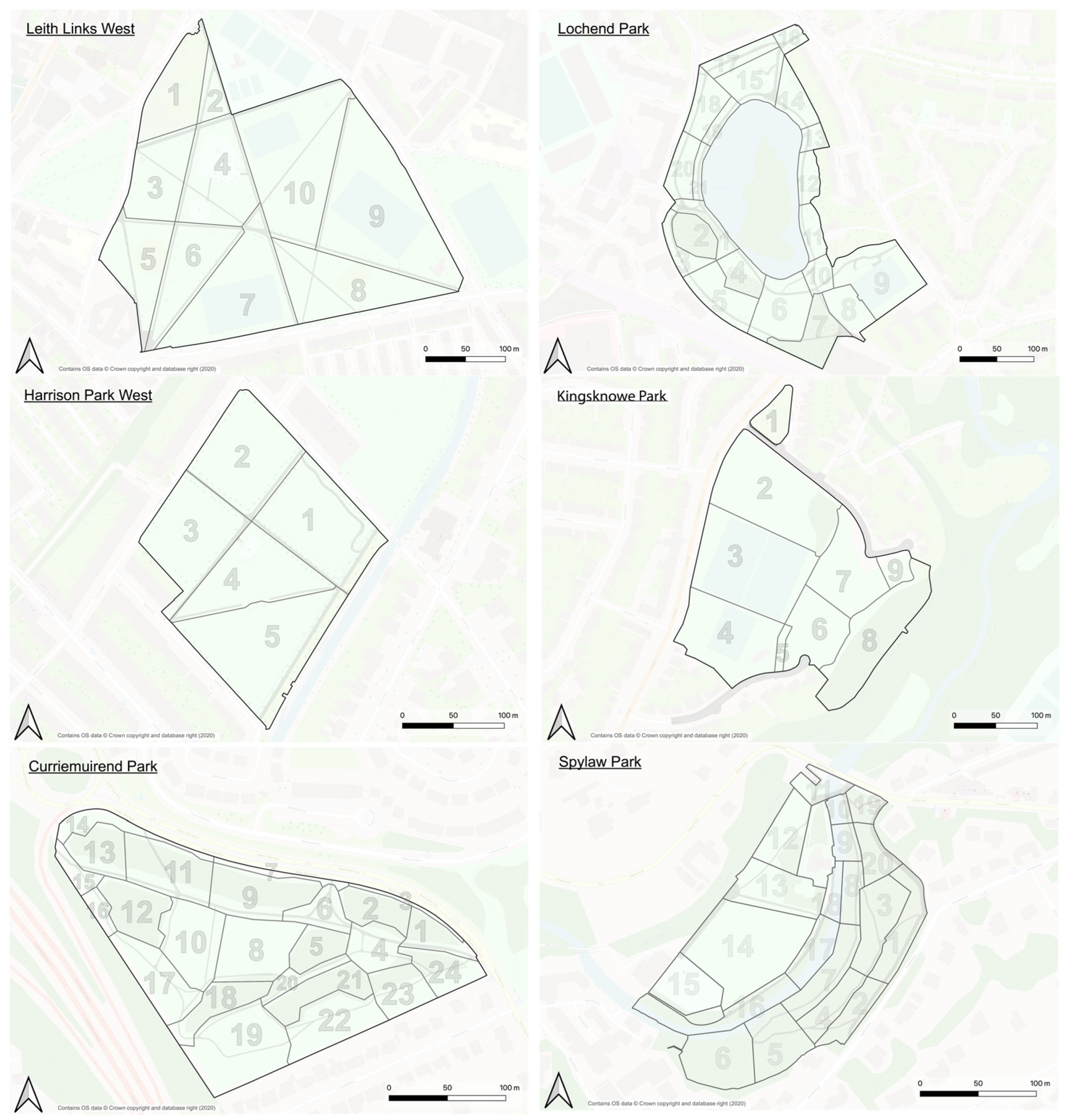
Appendix B. Behaviour Maps Based on All Observation Sessions in Each Park

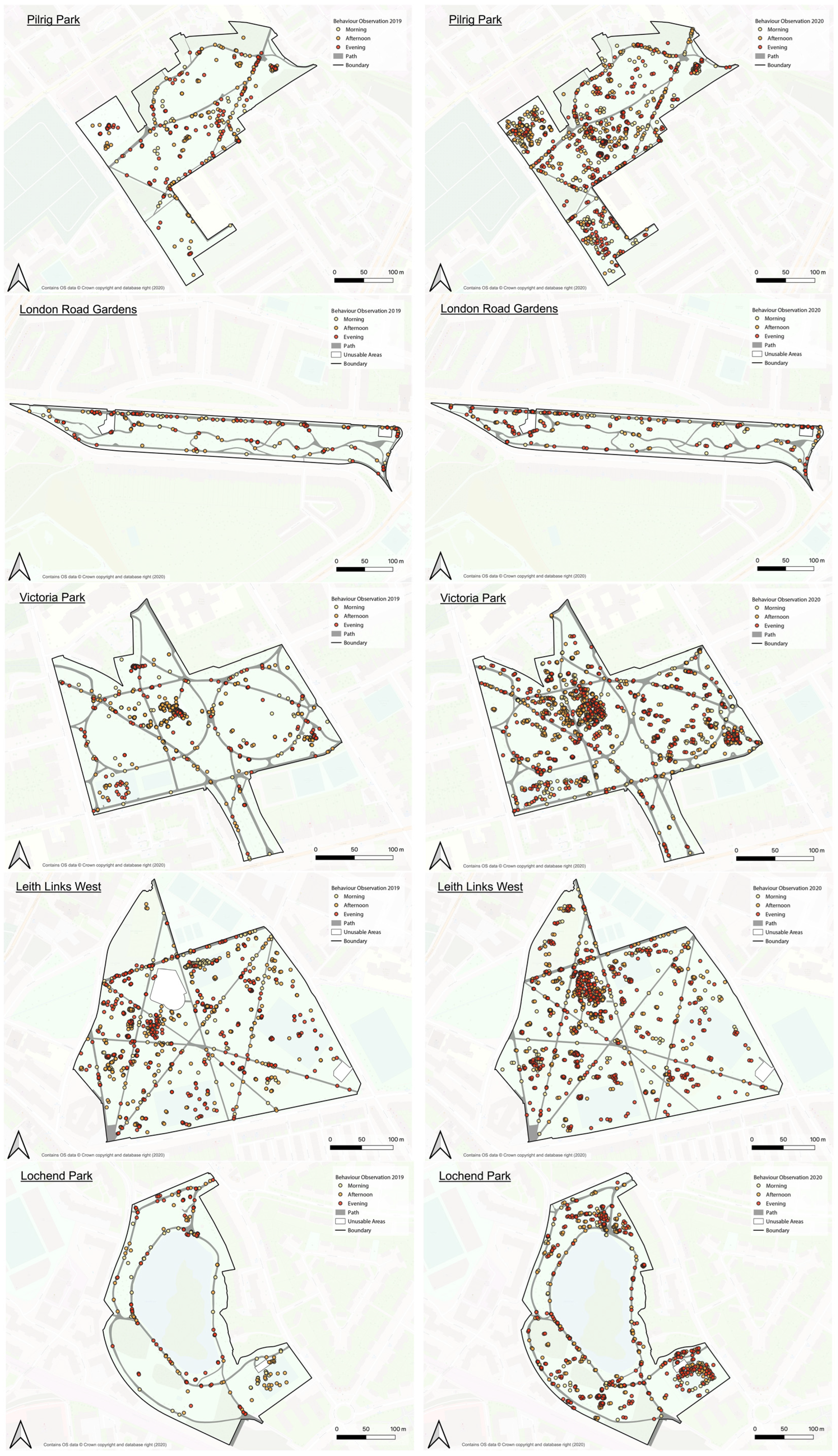
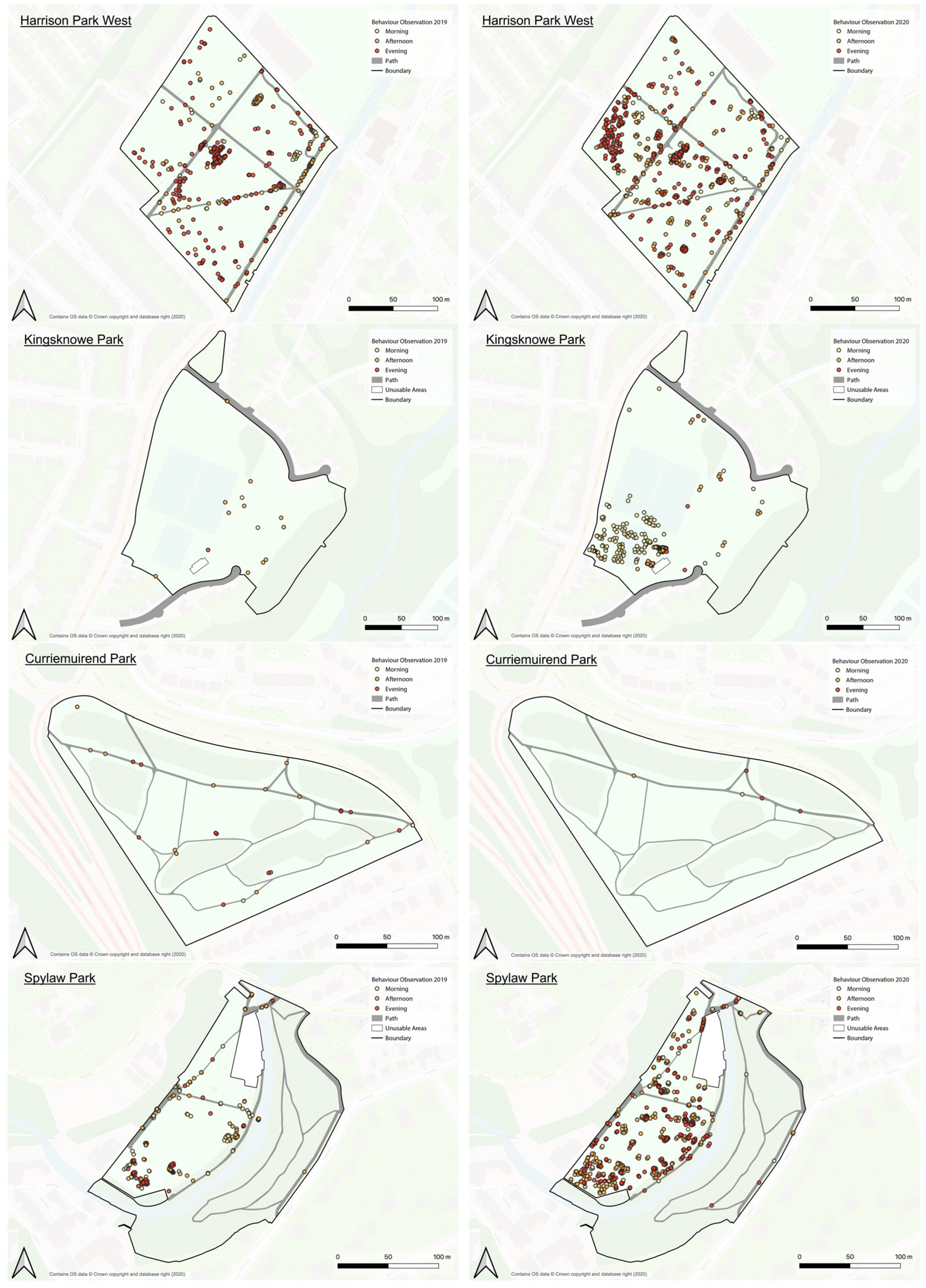
References
- Natural England. The People and Nature Survey for England: Monthly Interim Indicators for July 2020 (Experimental Statistics). 2021. Available online: https://www.gov.uk/government/statistics/the-people-and-nature-survey-for-england-monthly-interim-indicators-for-july-2020-experimental-statistics/the-people-and-nature-survey-for-england-monthly-interim-indicators-for-july-2020-experimental-statistics (accessed on 6 June 2021).
- Olsen, J.; Mitchell, R. S&SR Environment and Spaces Group Report: COVID-19 Green and Open Space Use in Autumn 2020. 2021. Available online: https://www.gla.ac.uk/media/Media_779126_smxx.pdf (accessed on 29 March 2023).
- Stewart, D.; Eccleston, J. Enjoying the Outdoors: Monitoring the Impact of Coronavirus and Social Distancing. 2020. Available online: https://www.nature.scot/doc/naturescot-research-report-1252-enjoying-outdoors-monitoring-impact-coronavirus-and-social (accessed on 29 March 2023).
- gov.scot. COVID-19 in Scotland; Scottish Government, Edinburgh, UK, 2022. Available online: https://data.gov.scot/coronavirus-covid-19/ (accessed on 15 November 2022).
- Stigsdotter, U.K.; Ekholm, O.; Schipperijn, J.; Toftager, M.; Kamper-Jørgensen, F.; Randrup, T.B. Health Promoting Outdoor Environments-Associations Between Green Space, and Health, Health-Related Quality of Life and Stress Based on a Danish National Representative Survey. Scand. J. Public Health 2010, 38, 411–417. [Google Scholar] [CrossRef]
- Hartig, T.; Mitchell, R.; De Vries, S.; Frumkin, H. Nature and health. Annu. Rev. Public Health 2014, 35, 207–228. [Google Scholar] [CrossRef] [PubMed]
- Bai, X.; Nath, I.; Capon, A.; Hasan, N.; Jaron, D. Health and Wellbeing in the Changing Urban Environment: Complex Challenges, Scientific Responses, and the Way Forward. Curr. Opin. Environ. Sustain. 2012, 4, 465–472. [Google Scholar] [CrossRef]
- Ward Thompson, C. Activity, Exercise and the Planning and Design of Outdoor Spaces. J. Environ. Psychol. 2013, 34, 79–96. [Google Scholar] [CrossRef]
- Berman, M.G.; Jonides, J.; Kaplan, S. The cognitive benefits of interacting with nature. Psychol. Sci. 2008, 19, 1207–1212. [Google Scholar] [CrossRef] [PubMed]
- Hartig, T.; Mang, M.; Evans, G.W. Restorative effects of natural environment experiences. Environ. Behav. 1991, 23, 3–26. [Google Scholar] [CrossRef]
- Li, Q.; Morimoto, K.; Kobayashi, M.; Inagaki, H.; Katsumata, M.; Hirata, Y.; Hirata, K.; Suzuki, H.; Li, Y.; Wakayama, Y. Visiting a forest, but not a city, increases human natural killer activity and expression of anti-cancer proteins. Int. J. Immunopathol. Pharmacol. 2008, 21, 117–127. [Google Scholar] [CrossRef]
- Ulrich, R.S.; Simons, R.F.; Losito, B.D.; Fiorito, E.; Miles, M.A.; Zelson, M. Stress recovery during exposure to natural and urban environments. J. Environ. Psychol. 1991, 11, 201–230. [Google Scholar] [CrossRef]
- Beil, K.; Hanes, D. The influence of urban natural and built environments on physiological and psychological measures of stress—A pilot study. Int. J. Environ. Res. Public Health 2013, 10, 1250–1267. [Google Scholar] [CrossRef] [PubMed]
- Carrus, G.; Scopelliti, M.; Lafortezza, R.; Colangelo, G.; Ferrini, F.; Salbitano, F.; Agrimi, M.; Portoghesi, L.; Semenzato, P.; Sanesi, G. Go greener, feel better? The positive effects of biodiversity on the well-being of individuals visiting urban and peri-urban green areas. Landsc. Urban Plan. 2015, 134, 221–228. [Google Scholar] [CrossRef]
- Grazuleviciene, R.; Vencloviene, J.; Kubilius, R.; Grizas, V.; Danileviciute, A.; Dedele, A.; Andrusaityte, S.; Vitkauskiene, A.; Steponaviciute, R.; Nieuwenhuijsen, M.J. Tracking restoration of park and urban street settings in coronary artery disease patients. Int. J. Environ. Res. Public Health 2016, 13, 550. [Google Scholar] [CrossRef] [PubMed]
- Song, C.; Ikei, H.; Igarashi, M.; Miwa, M.; Takagaki, M.; Miyazaki, Y. Physiological and psychological responses of young males during spring-time walks in urban parks. J. Physiol. Anthropol. 2014, 33, 8. [Google Scholar] [CrossRef] [PubMed]
- Tyrväinen, L.; Ojala, A.; Korpela, K.; Lanki, T.; Tsunetsugu, Y.; Kagawa, T. The influence of urban green environments on stress relief measures: A field experiment. J. Environ. Psychol. 2014, 38, 1–9. [Google Scholar] [CrossRef]
- Jones, K.R. ‘The Lungs of the City’: Green Space, Public Health and Bodily Metaphor in the Landscape of Urban Park History. Environ. Hist. 2018, 24, 39–58. [Google Scholar] [CrossRef]
- Alcock, I.; White, M.P.; Wheeler, B.W.; Fleming, L.E.; Depledge, M.H. Longitudinal Effects on Mental Health of Moving to Greener and Less Green Urban Areas. Environ. Sci. Technol. 2014, 48, 1247–1255. [Google Scholar] [CrossRef]
- Maas, J.; Verheij, R.A.; Groenewegen, P.P.; De Vries, S.; Spreeuwenberg, P. Green space, urbanity, and health: How strong is the relation? J. Epidemiol. Community Health 2006, 60, 587–592. [Google Scholar] [CrossRef]
- Roe, J.J.; Thompson, C.W.; Aspinall, P.A.; Brewer, M.J.; Duff, E.I.; Miller, D.; Mitchell, R.; Clow, A. Green space and stress: Evidence from cortisol measures in deprived urban communities. Int. J. Environ. Res. Public Health 2013, 10, 4086–4103. [Google Scholar] [CrossRef]
- Ward Thompson, C.; Roe, J.; Aspinall, P.; Mitchell, R.; Clow, A.; Miller, D. More green space is linked to less stress in deprived communities: Evidence from salivary cortisol patterns. Landsc. Urban Plan. 2012, 105, 221–229. [Google Scholar] [CrossRef]
- White, M.P.; Alcock, I.; Wheeler, B.W.; Depledge, M.H. Would you be happier living in a greener urban area? A fixed-effects analysis of panel data. Psychol. Sci. 2013, 24, 920–928. [Google Scholar] [CrossRef]
- Reklaitiene, R.; Grazuleviciene, R.; Dedele, A.; Virviciute, D.; Vensloviene, J.; Tamosiunas, A.; Baceviciene, M.; Luksiene, D.; Sapranaviciute-Zabazlajeva, L.; Radisauskas, R. The relationship of green space, depressive symptoms and perceived general health in urban population. Scand. J. Public Health 2014, 42, 669–676. [Google Scholar] [CrossRef]
- Van den Berg, M.; Van Poppel, M.; Van Kamp, I.; Andrusaityte, S.; Balseviciene, B.; Cirach, M.; Danileviciute, A.; Ellis, N.; Hurst, G.; Masterson, D. Visiting green space is associated with mental health and vitality: A cross-sectional study in four european cities. Health Place 2016, 38, 8–15. [Google Scholar] [CrossRef] [PubMed]
- Honold, J.; Lakes, T.; Beyer, R.; van der Meer, E. Restoration in urban spaces: Nature views from home, greenways, and public parks. Environ. Behav. 2016, 48, 796–825. [Google Scholar] [CrossRef]
- Hunter, M.R.; Gillespie, B.W.; Chen, S.Y.-P. Urban nature experiences reduce stress in the context of daily life based on salivary biomarkers. Front. Psychol. 2019, 10, 722. [Google Scholar] [CrossRef] [PubMed]
- Coley, R.L.; Sullivan, W.C.; Kuo, F.E. Where does community grow? The social context created by nature in urban public housing. Environ. Behav. 1997, 29, 468–494. [Google Scholar] [CrossRef]
- Kim, J.; Kaplan, R. Physical and psychological factors in sense of community: New urbanist Kentlands and nearby Orchard Village. Environ. Behav. 2004, 36, 313–340. [Google Scholar] [CrossRef]
- Fujiwara, D.; Dolan, P.; Lawton, R.; Behzadnejad, F.; Lagarde, A.; Maxwell, C.; Peytrignet, S. Wellbeing Costs of COVID-19 in the UK. 2020. Available online: https://ceci.hact.org.uk/wp-content/uploads/2020/05/jacobs-wellbeing-costs-of-covid-19-uk.pdf (accessed on 25 May 2022).
- Samuelsson, K.; Barthel, S.; Colding, J.; Macassa, G.; Giusti, M. Urban Nature as a Source of Resilience During Social Distancing Amidst the Coronavirus Pandemic. 2020. OSF Preprints. Available online: https://osf.io/3wx5a/ (accessed on 25 May 2022).
- Kleinschroth, F.; Kowarik, I. COVID-19 Crisis Demonstrates the Urgent Need for Urban Greenspaces. Front. Ecol. Environ. 2020, 18, 318. [Google Scholar] [CrossRef]
- Hubbard, G.; Daas, C.d.; Johnston, M.; Murchie, P.; Thompson, C.W.; Dixon, D. Are rurality, area deprivation, access to outside space, and green space associated with mental health during the COVID-19 pandemic? A cross sectional study (CHARIS-E). Int. J. Environ. Res. Public Health 2021, 18, 3869. [Google Scholar] [CrossRef]
- Geng, D.C.; Innes, J.; Wu, W.; Wang, G. Impacts of COVID-19 Pandemic on Urban Park Visitation: A Global Analysis. J. For. Res. 2021, 32, 553–567. [Google Scholar] [CrossRef]
- Poortinga, W.; Bird, N.; Hallingberg, B.; Phillips, R.; Williams, D. The Role of Perceived Public and Private Green Space in Subjective Health and Wellbeing during and after the First Peak of the COVID-19 Outbreak. Landsc. Urban Plan. 2021, 211, 104092. [Google Scholar] [CrossRef]
- Grima, N.; Corcoran, W.; Hill-James, C.; Langton, B.; Sommer, H.; Fisher, B. The importance of urban natural areas and urban ecosystem services during the COVID-19 pandemic. PLoS ONE 2020, 15, e0243344. [Google Scholar] [CrossRef]
- Burnett, H.; Olsen, J.R.; Mitchell, R. Green space visits and barriers to visiting during the COVID-19 pandemic: A three-wave nationally representative cross-sectional study of UK adults. Land 2022, 11, 503. [Google Scholar] [CrossRef]
- The Scottish Parliament. Timeline of Coronavirus (COVID-19) in Scotland. 2022. Available online: https://spice-spotlight.scot/2022/12/16/timeline-of-coronavirus-covid-19-in-scotland/ (accessed on 25 March 2023).
- gov.scot. Effective ‘Lockdown’ to Be Introduced. 2020. Available online: https://www.gov.scot/news/effective-lockdown-to-be-introduced/ (accessed on 25 March 2023).
- gov.scot. Lockdown Begins to Ease in Phase 1; Scottish Government, Edinburgh, UK. 2020. Available online: https://www.gov.scot/news/lockdown-begins-to-ease-in-phase-1/ (accessed on 15 November 2022).
- gov.scot. Gradual Introduction of Phase 2; Scottish Government, Edinburgh, UK. 2020. Available online: https://www.gov.scot/news/gradual-introduction-of-phase-2/ (accessed on 15 November 2022).
- gov.scot. Final Phase 2 Measures Confirmed. 2020. Available online: https://www.gov.scot/news/final-phase-2-measures-confirmed/ (accessed on 15 November 2022).
- Scottish Government. COVID-19—Framework for Decision Making: Scotland’s Route Map through and out of the Crisis. 2020. Available online: https://www.gov.scot/binaries/content/documents/govscot/publications/progress-report/2020/07/covid-19-scotlands-route-map-through-out-crisis-update-approach-physical-distancing-light-advice-scottish-government-covid-19-advisory-group/documents/scotlands-route-map-through-out-crisis-update-approach-physical-distancing-light-advice-scottish-government-covid-19-advisory-group/scotlands-route-map-through-out-crisis-update-approach-physical-distancing-light-advice-scottish-government-covid-19-advisory-group/govscot%3Adocument/scotlands-route-map-through-out-crisis-update-approach-physical-distancing-light-advice-scottish-government-covid-19-advisory-group.pdf (accessed on 25 March 2023).
- gov.scot. Moving to Phase 3 of Lockdown Route Map. 2020. Available online: https://www.gov.scot/news/moving-to-phase-3-of-lockdown-route-map/ (accessed on 15 November 2022).
- Stewart, D.; Eccleston, J. Enjoying the Outdoors: Monitoring the Impact of Coronavirus and Social Distancing—Wave 2 Survey Results (September 2020). 2020. Available online: https://www.nature.scot/doc/naturescot-research-report-1255-enjoying-outdoors-monitoring-impact-coronavirus-and-social (accessed on 29 March 2023).
- Natural England. The People and Nature Survey. 2020. Available online: https://www.gov.uk/government/collections/people-and-nature-survey-for-england#monthly-interim-indicators (accessed on 9 June 2021).
- Natural England. The People and Nature Survey for England: Monthly Interim Indicators for August 2020 (Experimental Statistics). 2021. Available online: https://www.gov.uk/government/statistics/the-people-and-nature-survey-for-england-monthly-interim-indicators-for-august-2020-experimental-statistics/the-people-and-nature-survey-for-england-monthly-interim-indicators-for-august-2020-experimental-statistics (accessed on 6 June 2021).
- Natural England. The People and Nature Survey for England: Monthly Interim Indicators for December 2020 (Experimental Statistics). 2021. Available online: https://www.gov.uk/government/statistics/the-people-and-nature-survey-for-england-monthly-interim-indicators-for-december-2020-experimental-statistics/the-people-and-nature-survey-for-england-monthly-interim-indicators-for-december-2020-experimental-statistics (accessed on 6 June 2021).
- Natural England. The People and Nature Survey for England: Monthly Interim Indicators for November 2020 (Experimental Statistics). 2021. Available online: https://www.gov.uk/government/statistics/the-people-and-nature-survey-for-england-monthly-interim-indicators-for-november-2020-experimental-statistics/the-people-and-nature-survey-for-england-monthly-interim-indicators-for-november-2020-experimental-statistics (accessed on 6 June 2021).
- Natural England. The People and Nature Survey for England: Monthly Interim Indicators for October 2020 (Experimental Statistics). 2021. Available online: https://www.gov.uk/government/statistics/the-people-and-nature-survey-for-england-monthly-interim-indicators-for-october-2020-experimental-statistics/the-people-and-nature-survey-for-england-monthly-interim-indicators-for-october-2020-experimental-statistics (accessed on 6 June 2021).
- Natural England. The People and Nature Survey for England: Monthly Interim Indicators for September 2020 (Experimental Statistics). 2021. Available online: https://www.gov.uk/government/statistics/the-people-and-nature-survey-for-england-monthly-interim-indicators-for-september-2020-experimental-statistics/the-people-and-nature-survey-for-england-monthly-interim-indicators-for-september-2020-experimental-statistics (accessed on 6 June 2021).
- Olsen, J.; Mitchell, R. S&SR Environment and Spaces Group: Change in Use of Green and Open Space Following COVID-19 Lockdown ‘Stay at Home’ Phase and Initial Easing of Lockdown. 2020. Available online: https://www.gla.ac.uk/media/Media_757600_smxx.pdf (accessed on 29 March 2023). [CrossRef]
- Bahriny, F.; Bell, S. Patterns of urban park use and their relationship to factors of quality: A case study of Tehran, Iran. Sustainability 2020, 12, 1560. [Google Scholar] [CrossRef]
- Goličnik, B.; Thompson, C.W. Emerging relationships between design and use of urban park spaces. Landsc. Urban Plan. 2010, 94, 38–53. [Google Scholar] [CrossRef]
- Kabisch, N.; Kraemer, R. Physical activity patterns in two differently characterised urban parks under conditions of summer heat. Environ. Sci. Policy 2020, 107, 56–65. [Google Scholar] [CrossRef]
- McCormack, G.R.; Rock, M.; Swanson, K.; Burton, L.; Massolo, A. Physical activity patterns in urban neighbourhood parks: Insights from a multiple case study. BMC Public Health 2014, 14, 962. [Google Scholar] [CrossRef]
- Ayala-Azcárraga, C.; Diaz, D.; Zambrano, L. Characteristics of urban parks and their relation to user well-being. Landsc. Urban Plan. 2019, 189, 27–35. [Google Scholar] [CrossRef]
- Bertram, C.; Meyerhoff, J.; Rehdanz, K.; Wüstemann, H. Differences in the recreational value of urban parks between weekdays and weekends: A discrete choice analysis. Landsc. Urban Plan. 2017, 159, 5–14. [Google Scholar] [CrossRef]
- Lin, B.B.; Fuller, R.A.; Bush, R.; Gaston, K.J.; Shanahan, D.F. Opportunity or orientation? Who uses urban parks and why. PLoS ONE 2014, 9, e87422. [Google Scholar] [CrossRef]
- Thorsson, S.; Lindqvist, M.; Lindqvist, S. Thermal bioclimatic conditions and patterns of behaviour in an urban park in Göteborg, Sweden. Int. J. Biometeorol. 2004, 48, 149–156. [Google Scholar] [CrossRef]
- Moore, R.C.; Cosco, N.G. Using behavior mapping to investigate healthy outdoor environments for children and families. In Innovative Approaches to Research Excellence in Landscape and Health; Routledge: New York, NY, USA, 2010; pp. 33–72. [Google Scholar]
- Ng, C.F. Behavioral Mapping and Tracking. In Research Methods for Environmental Psychology; Gifford, R., Ed.; Wiley-Blackwell: Chichester, UK, 2016. [Google Scholar]
- Zeisel, J. Observing Environmental Behavior. In Inquiry by Design: Tools for Environment-Behavior Research; Cambridge University Press: Cambridge, UK, 1984. [Google Scholar]
- Petrtýlová, R.; Jaššo, M. Behavioural mapping and online data as tools for socio-spatial analysis of public spaces–Bratislava, Slovakia waterfront case study. GeoScape 2022, 16, 39–54. [Google Scholar] [CrossRef]
- Rozman Cafuta, M. Framing the tourist spatial identity of a city as a tourist product. Int. J. Tour. Cities 2022. [Google Scholar] [CrossRef]
- Open Space Plan for Edinburgh; Town Planning Department, Corporation of the City of Edinburgh: Edinburgh, UK, 1969.
- City of Edinburgh Council. The City of Edinburgh Council Atlas. Available online: http://data.edinburghcouncilmaps.info/datasets/223949a6212f4068b30aa6ed8fc2e1ef_15?uiTab=table&filterByExtent=false&orderByFields=Area_ha+DESC (accessed on 1 March 2019).
- Google Maps. Bloomiehall Park. 2019. Available online: https://www.google.com/maps/@55.9053653,-3.2898817,358m/data=!3m1!1e3 (accessed on 13 May 2019).
- Google Maps. Liberton Gardens Park. 2019. Available online: https://www.google.com/maps/@55.9107802,-3.1661075,527m/data=!3m1!1e3 (accessed on 13 May 2019).
- Google Maps. Victoria Park. 2019. Available online: https://www.google.com/maps/@55.9751197,-3.1946501,527m/data=!3m1!1e3 (accessed on 13 May 2019).
- Ittelson, W.H.; Rivlin, L.G.; Proshansky, H.M. The use of behavioral maps in environmental psychology. In Environmental Psychology: Man and His Physical Setting; Proshansky, H.M., Ittelson, W.H., Rivlin, L.G., Eds.; Holt, Rinehart and Winston: New York, NY, USA, 1970; pp. 658–668. [Google Scholar]
- Ordnance Survey. OS MasterMap Green Space; EDINA Digimap Ordnance Survey Service: Edinburgh, UK, 2019; Available online: https://www.ordnancesurvey.co.uk/products/os-mastermap-greenspace-layer (accessed on 4 January 2020).
- Ordnance Survey. Scotland’s Greenspace Map; EDINA Digimap Ordnance Survey Service: Edinburgh, UK, 2012; Available online: http://digimap.edina.ac.uk/ (accessed on 4 January 2020).
- Ordnance Survey. OS Open Greenspace; EDINA Digimap Ordnance Survey Service: Edinburgh, UK, 2019; Available online: https://www.ordnancesurvey.co.uk/products/os-open-greenspace (accessed on 4 January 2020).
- Grahn, P. Landscapes in our minds: People’s choice of recreative places in towns. Landsc. Res. 1991, 16, 11–19. [Google Scholar] [CrossRef]
- Stigsdotter, U.K.; Grahn, P. Stressed individuals’ preferences for activities and environmental characteristics in green spaces. Urban For. Urban Green. 2011, 10, 295–304. [Google Scholar] [CrossRef]
- Zhang, H.; Chen, B.; Sun, Z.; Bao, Z. Landscape perception and recreation needs in urban green space in Fuyang, Hangzhou, China. Urban For. Urban Green. 2013, 12, 44–52. [Google Scholar] [CrossRef]
- Adinolfi, C.; Suárez-Cáceres, G.P.; Carinanos, P. Relation Between Visitors’ Behaviour and Characteristics of Green Spaces in the City of Granada, South-Eastern Spain. Urban For. Urban Green. 2014, 13, 534–542. [Google Scholar] [CrossRef]
- McKenzie, T.L.; Cohen, D.A.; Sehgal, A.; Williamson, S.; Golinelli, D. System for Observing Play and Recreation in Communities (SOPARC): Reliability and feasibility measures. J. Phys. Act. Health 2006, 3, S208–S222. [Google Scholar] [CrossRef] [PubMed]
- McKenzie, T.L. Context matters: Systematic observation of place-based physical activity. Res. Q. Exerc. Sport 2016, 87, 334–341. [Google Scholar] [CrossRef]
- Shores, K.A.; West, S.T. Rural and urban park visits and park-based physical activity. Prev. Med. 2010, 50, S13–S17. [Google Scholar] [CrossRef]
- Van Dyck, D.; Sallis, J.F.; Cardon, G.; Deforche, B.; Adams, M.A.; Geremia, C.; De Bourdeaudhuij, I. Associations of neighborhood characteristics with active park use: An observational study in two cities in the USA and Belgium. Int. J. Health Geogr. 2013, 12, 1–9. [Google Scholar] [CrossRef]
- Cohen, D.A.; Marsh, T.; Williamson, S.; Han, B.; Derose, K.P.; Golinelli, D.; McKenzie, T.L. The potential for pocket parks to increase physical activity. Am. J. Health Promot. 2014, 28, S19–S26. [Google Scholar] [CrossRef]
- Benton, J.S.; Anderson, J.; Pulis, M.; Cotterill, S.; Hunter, R.F.; French, D.P. Method for observing pHysical activity and wellbeing (MOHAWk): Validation of an observation tool to assess physical activity and other wellbeing behaviours in urban spaces. Cities Health 2022, 6, 818–832. [Google Scholar] [CrossRef]
- Veitch, J.; Carver, A.; Abbott, G.; Giles-Corti, B.; Timperio, A.; Salmon, J. How active are people in metropolitan parks? An observational study of park visitation in Australia. BMC Public Health 2015, 15, 610. [Google Scholar] [CrossRef] [PubMed]
- Ainsworth, B.E.; Haskell, W.L.; Leon, A.S.; Jacobs, D.R., Jr.; Montoye, H.J.; Sallis, J.F.; Paffenbarger, R.S., Jr. Compendium of physical activities: Classification of energy costs of human physical activities. Med. Sci. Sports Exerc. 1993, 25, 71–80. [Google Scholar] [CrossRef] [PubMed]
- Ainsworth, B.E.; Haskell, W.L.; Whitt, M.C.; Irwin, M.L.; Swartz, A.M.; Strath, S.J.; O’Brien, W.L.; Bassett, D.R., Jr.; Schmitz, K.H.; Emplaincourt, P.O.; et al. Compendium of physical activities: An update of activity codes and MET intensities. Med. Sci. Sports Exerc. 2000, 32, S498–S504. [Google Scholar] [CrossRef]
- Ainsworth, B.E.; Haskell, W.L.; Herrmann, S.D.; Meckes, N.; Bassett, D.R., Jr.; Tudor-Locke, C.; Greer, J.L.; Vezina, J.; Whitt-Glover, M.C.; Leon, A.S. 2011 Compendium of Physical Activities: A second update of codes and MET values. Med. Sci. Sports Exerc. 2011, 43, 1575–1581. [Google Scholar] [CrossRef]
- Sevilla, A.; Smith, S. Baby steps: The gender division of childcare during the COVID-19 pandemic. Oxf. Rev. Econ. Policy 2020, 36, S169–S186. [Google Scholar] [CrossRef]
- Scottish Government. School Age Childcare: Progress Report. 2021. Available online: https://www.gov.scot/publications/school-age-childcare-progress-report/pages/4/ (accessed on 19 February 2023).
- Age UK. Age UK Research on Impact of the Pandemic on Our Older Population’s Health. 2020. Available online: https://www.ageuk.org.uk/latest-press/articles/2020/10/age-uk--research-into-the-effects-of-the-pandemic-on-the-older-populations-health/ (accessed on 15 November 2022).
- Understanding Society. Data Dashboard: COVID-19. Available online: https://www.understandingsociety.ac.uk/topic/covid-19/data-dashboard (accessed on 29 March 2023).
- Mukherjee, S.; Pahan, K. Is COVID-19 gender-sensitive? J. Neuroimmune Pharmacol. 2021, 16, 38–47. [Google Scholar] [CrossRef]
- Docherty, A.B.; Harrison, E.M.; Green, C.A.; Hardwick, H.E.; Pius, R.; Norman, L.; Holden, K.A.; Read, J.M.; Dondelinger, F.; Carson, G. Features of 20 133 UK patients in hospital with COVID-19 using the ISARIC WHO Clinical Characterisation Protocol: Prospective observational cohort study. BMJ 2020, 369, m1985. [Google Scholar] [CrossRef]
- The Guardian. Coronavirus: Over 70% of Critical Care Patients in UK Are Men. 2020. Available online: https://www.theguardian.com/world/2020/may/01/coronavirus-uk-over-70-of-critical-care-patients-are-men (accessed on 15 April 2023).
- Gebhard, C.; Regitz-Zagrosek, V.; Neuhauser, H.K.; Morgan, R.; Klein, S.L. Impact of sex and gender on COVID-19 outcomes in Europe. Biol. Sex Differ. 2020, 11, 29. [Google Scholar] [CrossRef]
- Office for National Statistics. Coronavirus (COVID-19) and the Different Effects on Men and Women in the UK, March 2020 to February 2021. 2021. Available online: https://www.ons.gov.uk/peoplepopulationandcommunity/healthandsocialcare/conditionsanddiseases/articles/coronaviruscovid19andthedifferenteffectsonmenandwomenintheukmarch2020tofebruary2021/2021-03-10 (accessed on 29 March 2023).
- Pradhan, A.; Olsson, P.-E. Sex differences in severity and mortality from COVID-19: Are males more vulnerable? Biol. Sex Differ. 2020, 11, 53. [Google Scholar] [CrossRef]
- Galasso, V.; Pons, V.; Profeta, P.; Becher, M.; Brouard, S.; Foucault, M. Gender differences in COVID-19 attitudes and behavior: Panel evidence from eight countries. Proc. Natl. Acad. Sci. USA 2020, 117, 27285–27291. [Google Scholar] [CrossRef] [PubMed]
- Oreffice, S.; Quintana-Domeque, C. Gender inequality in COVID-19 times: Evidence from UK prolific participants. J. Demogr. Econ. 2021, 87, 261–287. [Google Scholar] [CrossRef]
- Etheridge, B.; Spantig, L. The gender gap in mental well-being at the onset of the COVID-19 pandemic: Evidence from the UK. Eur. Econ. Rev. 2022, 145, 104114. [Google Scholar] [CrossRef] [PubMed]
- NHS England. Around One Million Downloads of Fitness App during Lockdown as People Stay Fit. 2020. Available online: https://www.england.nhs.uk/2020/07/around-one-million-downloads-of-fitness-app-during-lockdown-as-people-stay-fit/ (accessed on 15 February 2023).
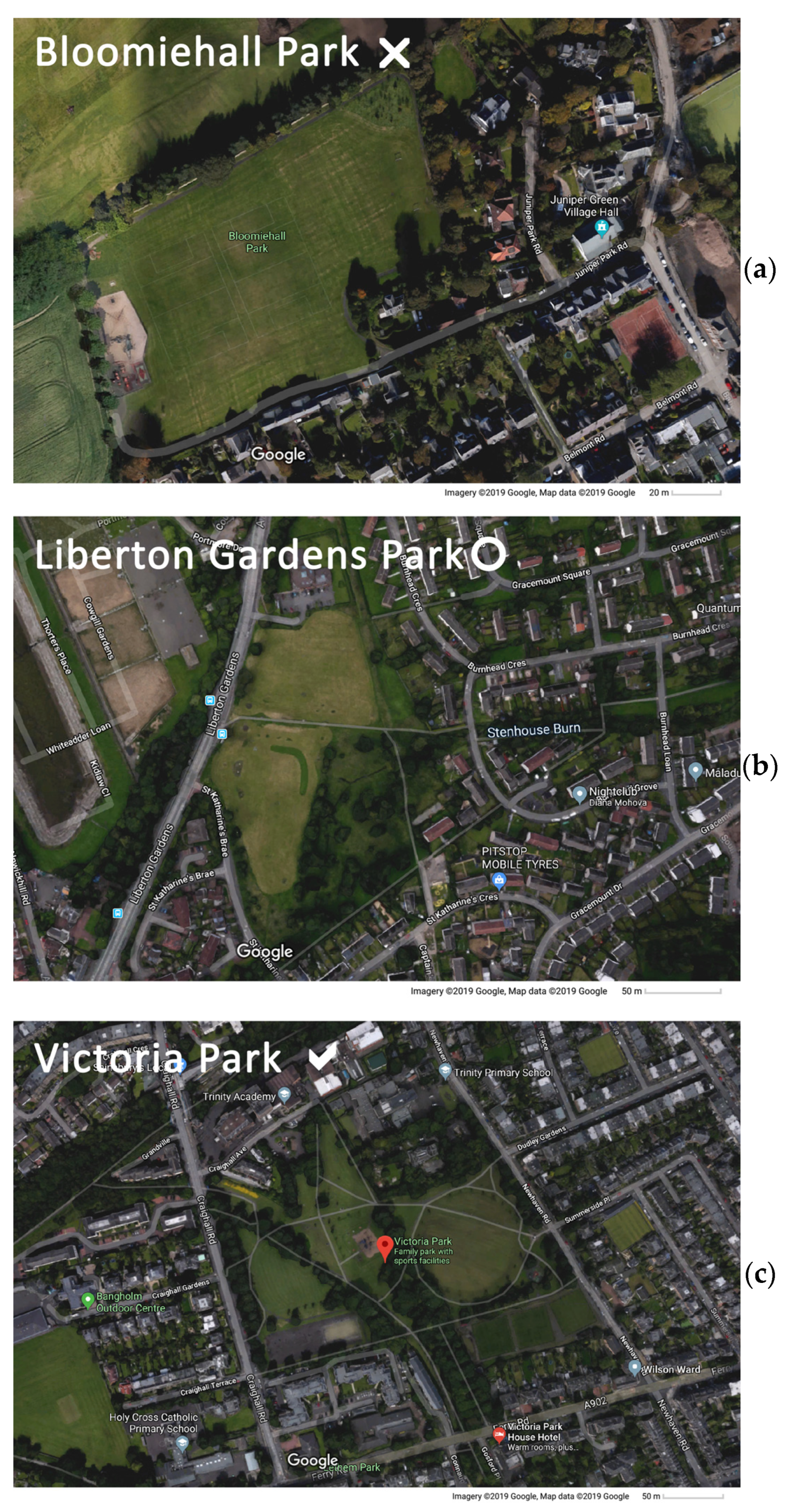



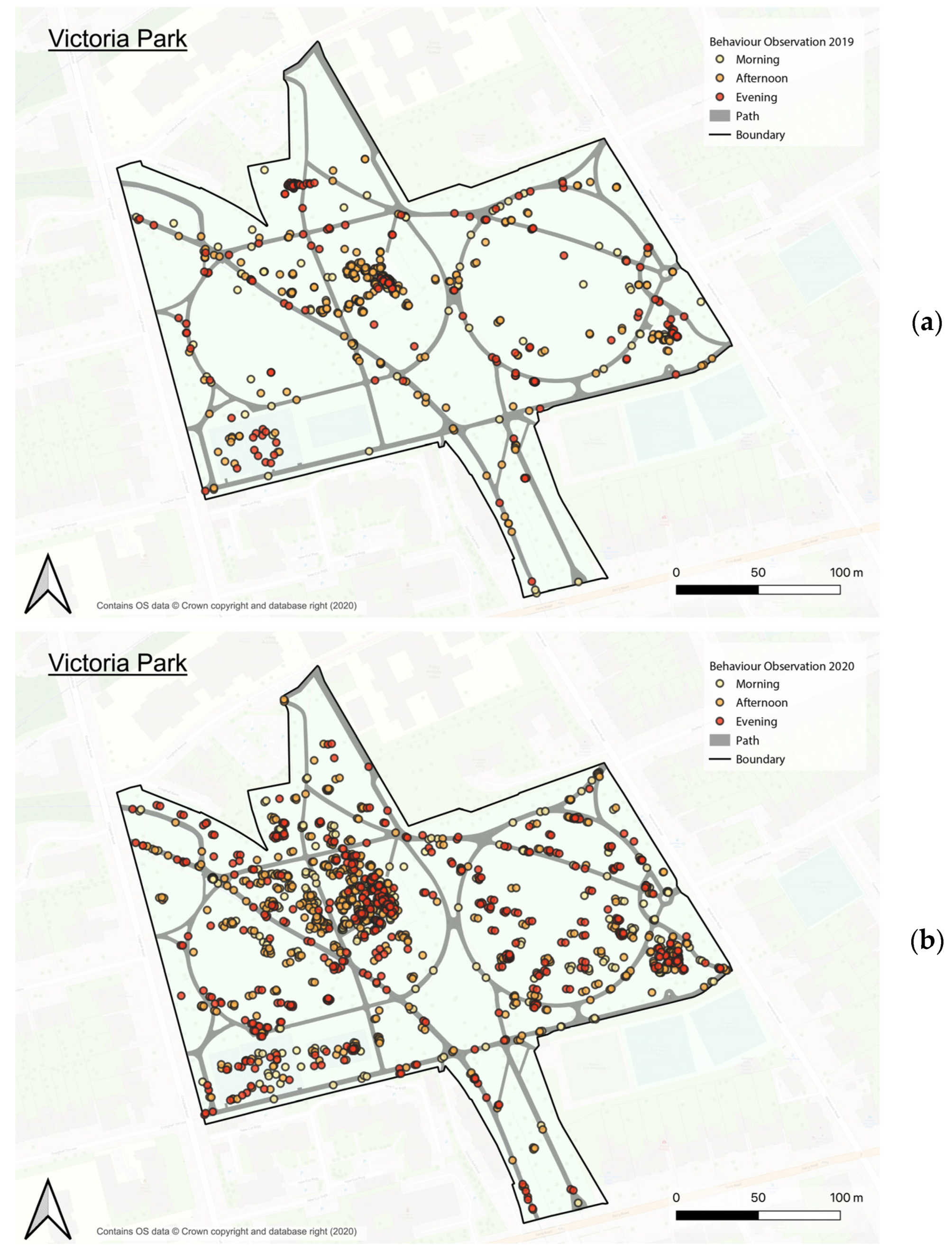
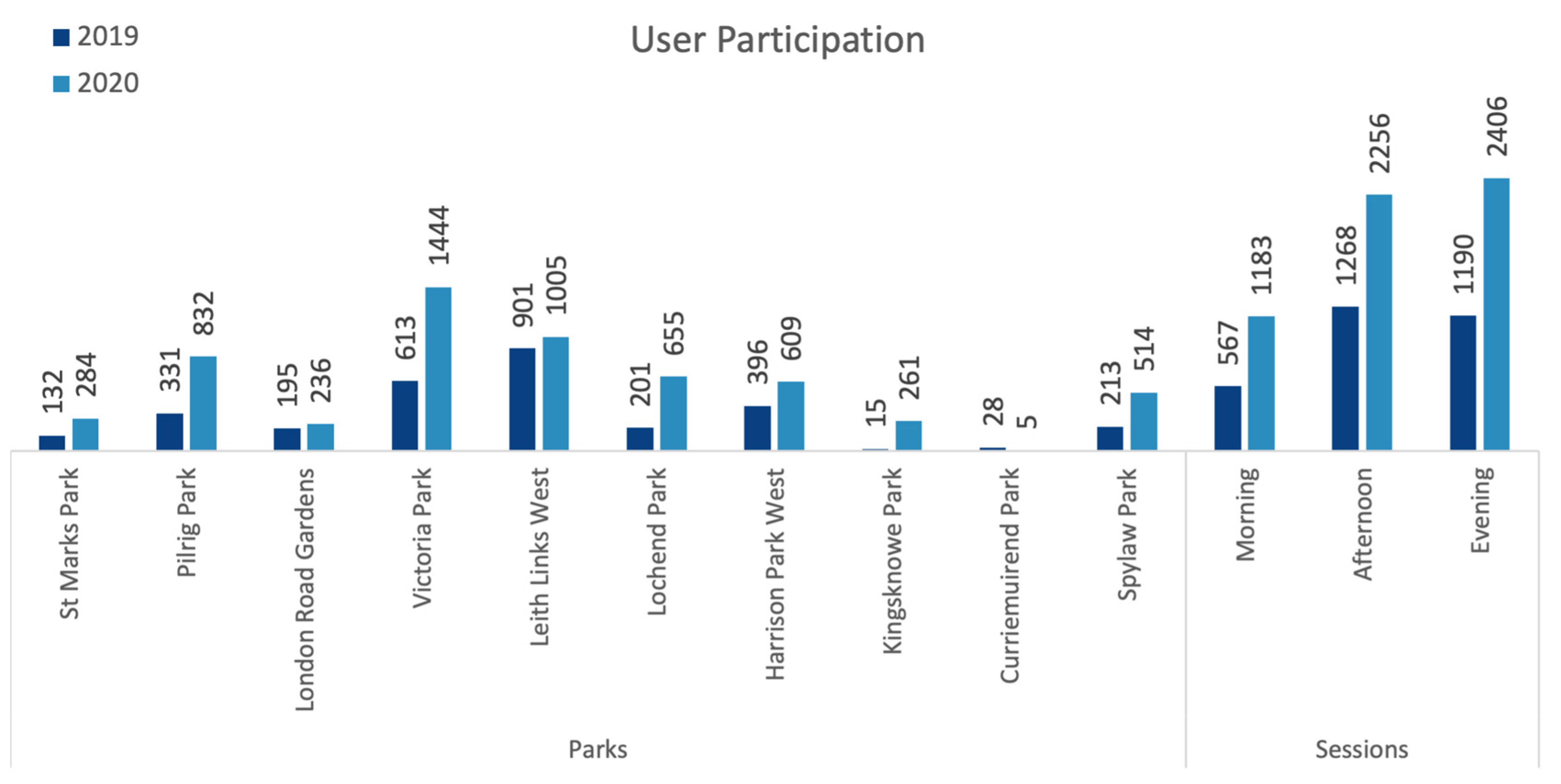
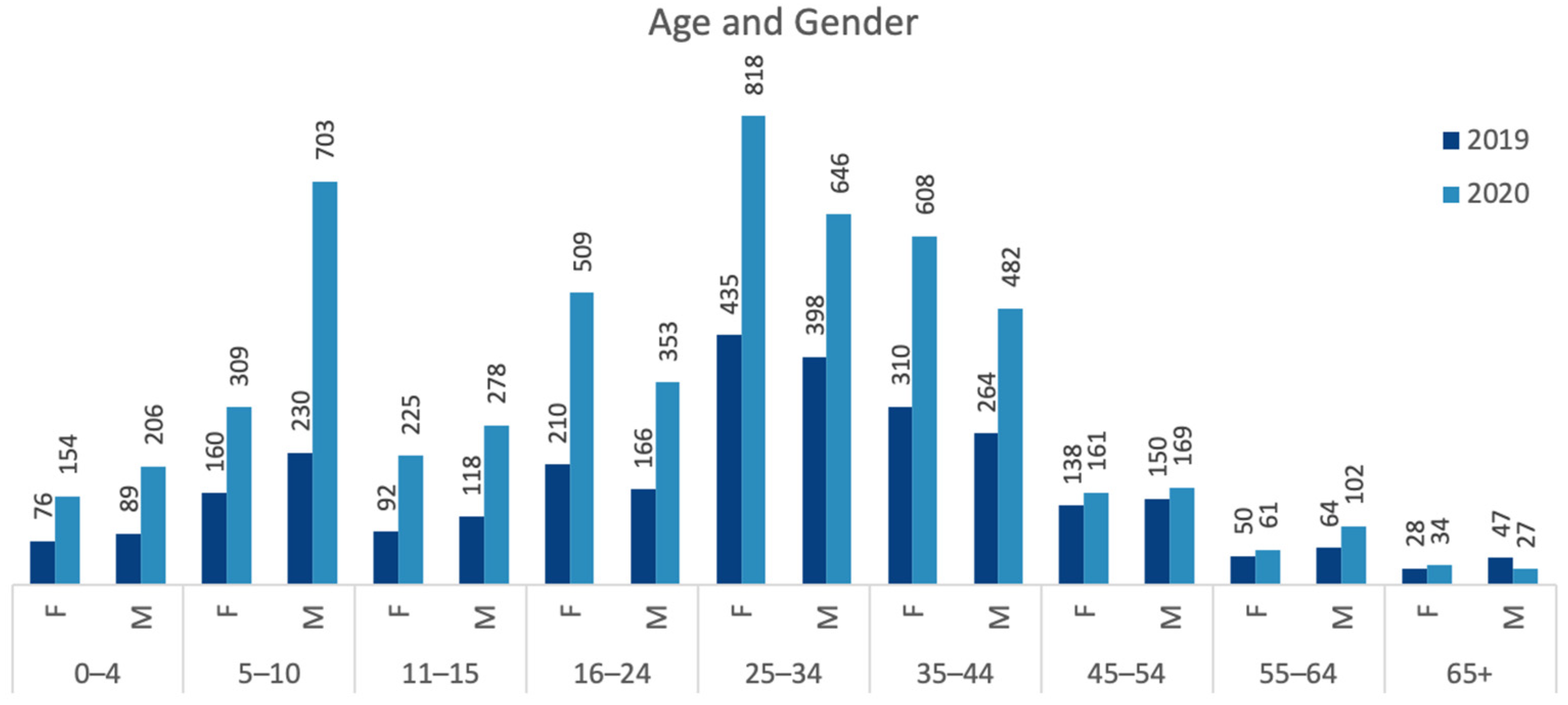



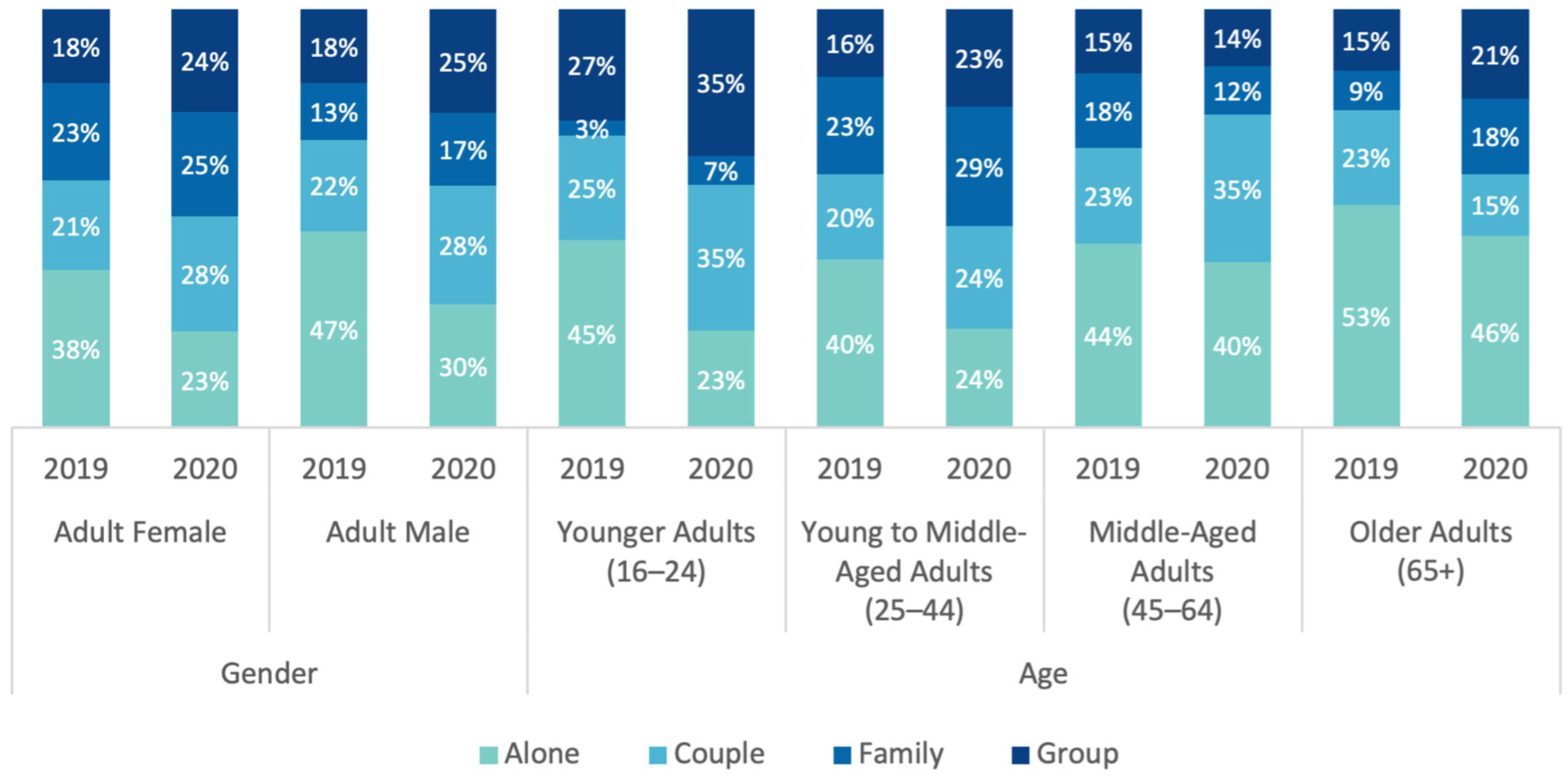

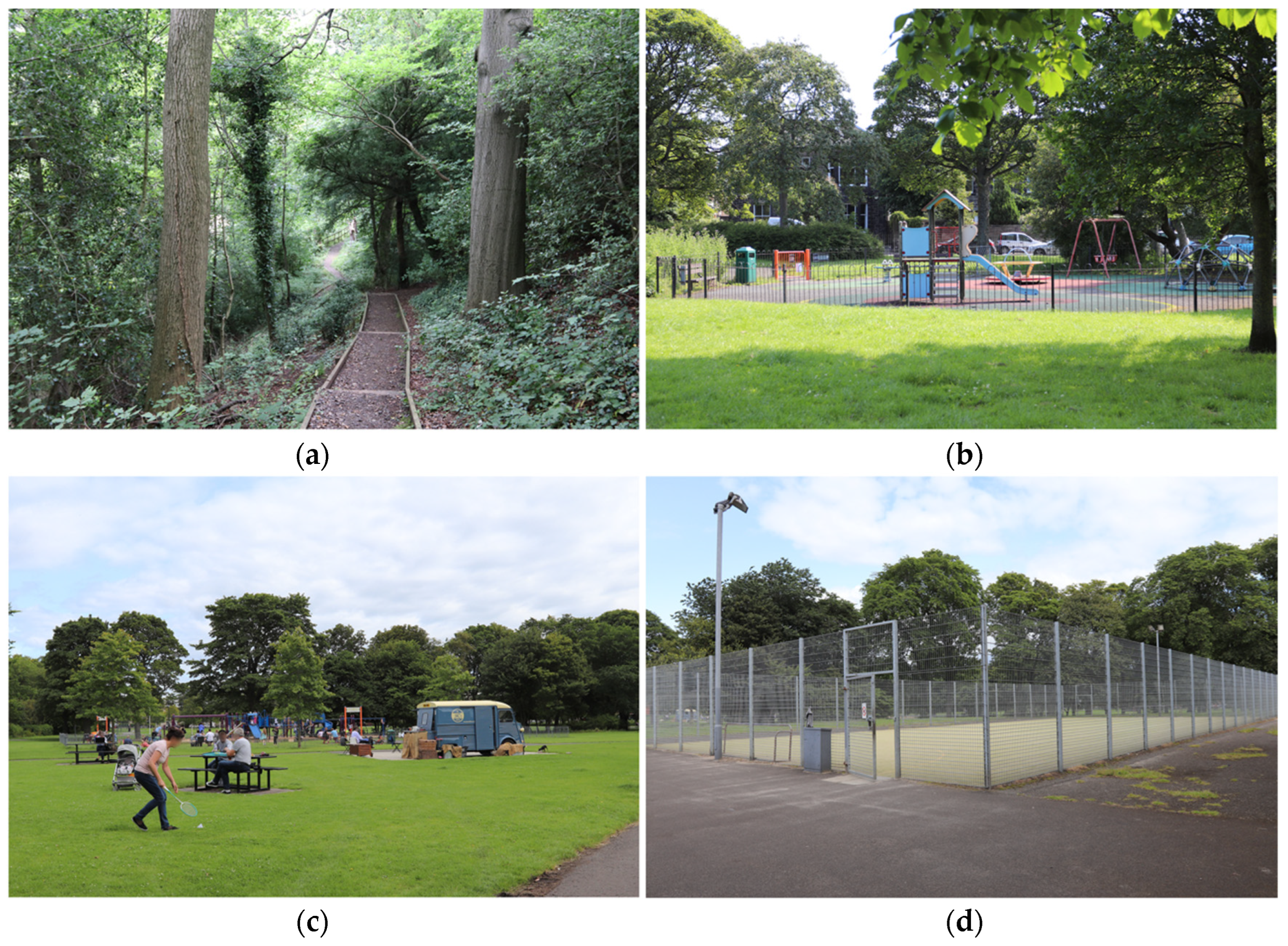
| Park Name | Total Park Area * (ha) | Number of Observation Zones |
|---|---|---|
| St Marks Park | 4.73 | 7 |
| Pilrig Park | 6.89 | 17 |
| London Road Gardens | 4.13 | 27 |
| Victoria Park | 6.16 | 17 |
| Leith Links West | 9.97 ** | 10 |
| Lochend Park | 8.40 | 21 |
| Harrison Park West | 3.99 | 5 |
| Kingsknowe Park | 6.04 | 9 |
| Curriemuirend Park | 4.42 | 24 |
| Spylaw Park | 3.65 | 20 |
| Physical Activity Categories | Sedentary Activities | Low Level Activities | Medium Level Activities | High Level Activities |
| Lying Down Picnicking Sitting | Standing | Walking | Ball Games Cycling Exercise Jogging Playing in Playground Running and Playing | |
| Social Categories | Alone Activities | Couple Activities | Family Activities | Group Activities |
| Variables | Categories | 2019 | 2020 | Difference between Survey Waves | |
|---|---|---|---|---|---|
| TOTAL | 3025 | 5845 | |||
| Visited Park | |||||
| St Marks Park | 132 (4.4%) | 284 (4.9%) | χ2(9) = 407.093 p < 0.05 | ||
| Pilrig Park | 331 (10.9%) | 832 (14.2%) | |||
| London Road Gardens | 195 (6.4%) | 236 (4.0%) | |||
| Victoria Park | 613 (20.3%) | 1444 (24.7%) | |||
| Leith Links West | 901 (29.8%) | 1005 (17.2%) | |||
| Lochend Park | 201 (6.6%) | 655 (11.2%) | |||
| Harrison Park West | 396 (13.1%) | 609 (10.4%) | |||
| Kingsknowe Park | 15 (0.5%) | 261 (4.5%) | |||
| Curriemuirend Park | 28 (0.9%) | 5 (0.1%) | |||
| Spylaw Park | 213 (7.0%) | 514 (8.8%) | |||
| Session | |||||
| Morning | 567 (18.7%) | 1183 (20.2%) | χ2(2) = 9.428 p < 0.05 | ||
| Afternoon | 1268 (41.9%) | 2256 (38.6%) | |||
| Evening | 1190 (39.3%) | 2406 (41.2%) | |||
| Age | |||||
| 0–4 | 165 (5.5%) | 360 (6.2%) | χ2(8) = 121.630 p < 0.05 | ||
| 5–10 | 390 (12.9%) | 1012 (17.3%) | |||
| 10–15 | 210 (6.9%) | 503 (8.6%) | |||
| 16–24 | 376 (12.4%) | 862 (14.7%) | |||
| 25–34 | 833 (27.5%) | 1464 (25.0%) | |||
| 35–44 | 574 (19.0%) | 1090 (18.6%) | |||
| 45–54 | 288 (9.5%) | 330 (5.6%) | |||
| 55–64 | 114 (3.8%) | 163 (2.8%) | |||
| 65+ | 75 (2.5%) | 61 (1.0%) | |||
| Gender | |||||
| Overall | |||||
| Female | 1499 (49.6%) | 2879 (49.3%) | χ2(1) = 0.071 p > 0.05 | ||
| Male | 1526 (50.4%) | 2966 (50.7%) | |||
| Adults | |||||
| Female | 1171 (51.8%) | 2191 (55.2%) | χ2(1) = 6.602 p < 0.05 | ||
| Male | 1089 (48.2%) | 1779 (44.8%) | |||
| Activity | |||||
| Lying Down | 105 (3.5%) | 119 (2.0%) | χ2(10) = 162.579 p < 0.05 | ||
| Picnicking | 157 (5.3%) | 235 (4.0%) | |||
| Sitting | 633 (21.2%) | 1629 (27.9%) | |||
| Standing | 594 (19.9%) | 1140 (19.5%) | |||
| Walking | 983 (32.9%) | 1388 (23.8%) | |||
| Ball Games | 108 (3.6%) | 309 (5.3%) | |||
| Cycling | 64 (2.1%) | 123 (2.1%) | |||
| Exercise | 24 (0.8%) | 108 (1.8%) | |||
| Jogging | 36 (1.2%) | 74 (1.3%) | |||
| Playing in Playground | 208 (7.0%) | 561 (9.6%) | |||
| Running and Playing | 73 (2.4%) | 156 (2.7%) | |||
| Broad Activity | |||||
| Sedentary Activities | 895 (30.0%) | 1983 (33.9%) | χ2(3) = 101.161 p < 0.05 | ||
| Low-Level Activities | 594 (19.9%) | 1140 (19.5%) | |||
| Medium-Level Activities | 983 (32.9%) | 1388 (23.8%) | |||
| High-Level Activities | 513 (17.2%) | 1331 (22.8%) | |||
| Social | |||||
| Alone | 1025 (33.9%) | 1135 (19.4%) | χ2(3) = 237.194 p < 0.05 | ||
| Couple | 554 (18.3%) | 1326 (22.7%) | |||
| Family | 768 (25.4%) | 1618 (27.7%) | |||
| Group | 678 (22.4%) | 1766 (30.2%) | |||
| Presence of Dogs | |||||
| Without Dogs | 2564 (84.8%) | 5263 (90.0%) | χ2(1) = 53.607 p < 0.05 | ||
| With Dogs | 461 (15.2%) | 582 (10.0%) | |||
| Park Usage | |||||
| Social | 109 (3.6%) | 452 (7.7%) | χ2(5) = 186.517 p < 0.05 | ||
| Playground | 442 (14.6%) | 959 (16.4%) | |||
| Sports and Fitness | 79 (2.6%) | 297 (5.1%) | |||
| Woodlands | 25 (0.8%) | 67 (1.1%) | |||
| Paths | 992 (32.8%) | 1270 (21.7%) | |||
| Other Park Areas | 1378 (45.6%) | 2800 (47.9%) | |||
| Group Size | |||||
| M = 3.17 Mdn = 2 | M = 3.44 Mdn = 2 | U = 7,398,991 z = −13.3, p < 0.05 | |||
| Experienced Density of People | |||||
| Without Any Group Members | |||||
| 2 m | M = 0.11 SE = 0.01 | M = 0.08 SE = 0.006 | t(5800.5) = 2.36 p < 0.05, r = 0.03 * | ||
| 5 m | M = 0.51 SE = 0.029 | M = 0.63 SE = 0.029 | t(8035.7) = −3.08 p < 0.05, r = 0.03 * | ||
| 10 m | M = 1.42 SE = 0.063 | M = 2.19 SE = 0.07 | t(8467.5) = −8.19 p < 0.05, r = 0.09 * | ||
| 20 m | M = 3.24 SE = 0.116 | M = 6.61 SE = 0.152 | t(8855.5) = −17.59 p < 0.05, r = 0.18 * | ||
| 50 m | M = 10.44 SE = 0.24 | M = 22.82 SE = 0.331 | t(8888.1) = −30.28 p < 0.05, r = 0.31 * | ||
| With Any Group Members | |||||
| 2 m | M = 0.95 SE = 0.026 | M = 1.03 SE = 0.022 | t(7078.9) = −2.40 p < 0.05, r = 0.03 * | ||
| 5 m | M = 1.92 SE = 0.049 | M = 2.4 SE = 0.044 | t(7447.3) = −7.33 p < 0.05, r = 0.08 * | ||
| 10 m | M = 3.15 SE = 0.079 | M = 4.24 SE = 0.081 | t(8106.9) = −9.59 p < 0.05, r = 0.11 * | ||
| 20 m | M = 5.25 SE = 0.129 | M = 8.87 SE = 0.158 | t(8760.8) = −17.78 p < 0.05, r = 0.19 * | ||
| 50 m | M = 12.61 SE = 0.245 | M = 25.25 SE = 0.335 | t(8886.7) = −30.45 p < 0.05, r = 0.31 * | ||
Disclaimer/Publisher’s Note: The statements, opinions and data contained in all publications are solely those of the individual author(s) and contributor(s) and not of MDPI and/or the editor(s). MDPI and/or the editor(s) disclaim responsibility for any injury to people or property resulting from any ideas, methods, instructions or products referred to in the content. |
© 2023 by the authors. Licensee MDPI, Basel, Switzerland. This article is an open access article distributed under the terms and conditions of the Creative Commons Attribution (CC BY) license (https://creativecommons.org/licenses/by/4.0/).
Share and Cite
Deniz Kiraz, L.; Ward Thompson, C. How Much Did Urban Park Use Change under the COVID-19 Pandemic? A Comparative Study of Summertime Park Use in 2019 and 2020 in Edinburgh, Scotland. Int. J. Environ. Res. Public Health 2023, 20, 7001. https://doi.org/10.3390/ijerph20217001
Deniz Kiraz L, Ward Thompson C. How Much Did Urban Park Use Change under the COVID-19 Pandemic? A Comparative Study of Summertime Park Use in 2019 and 2020 in Edinburgh, Scotland. International Journal of Environmental Research and Public Health. 2023; 20(21):7001. https://doi.org/10.3390/ijerph20217001
Chicago/Turabian StyleDeniz Kiraz, Leyla, and Catharine Ward Thompson. 2023. "How Much Did Urban Park Use Change under the COVID-19 Pandemic? A Comparative Study of Summertime Park Use in 2019 and 2020 in Edinburgh, Scotland" International Journal of Environmental Research and Public Health 20, no. 21: 7001. https://doi.org/10.3390/ijerph20217001
APA StyleDeniz Kiraz, L., & Ward Thompson, C. (2023). How Much Did Urban Park Use Change under the COVID-19 Pandemic? A Comparative Study of Summertime Park Use in 2019 and 2020 in Edinburgh, Scotland. International Journal of Environmental Research and Public Health, 20(21), 7001. https://doi.org/10.3390/ijerph20217001





